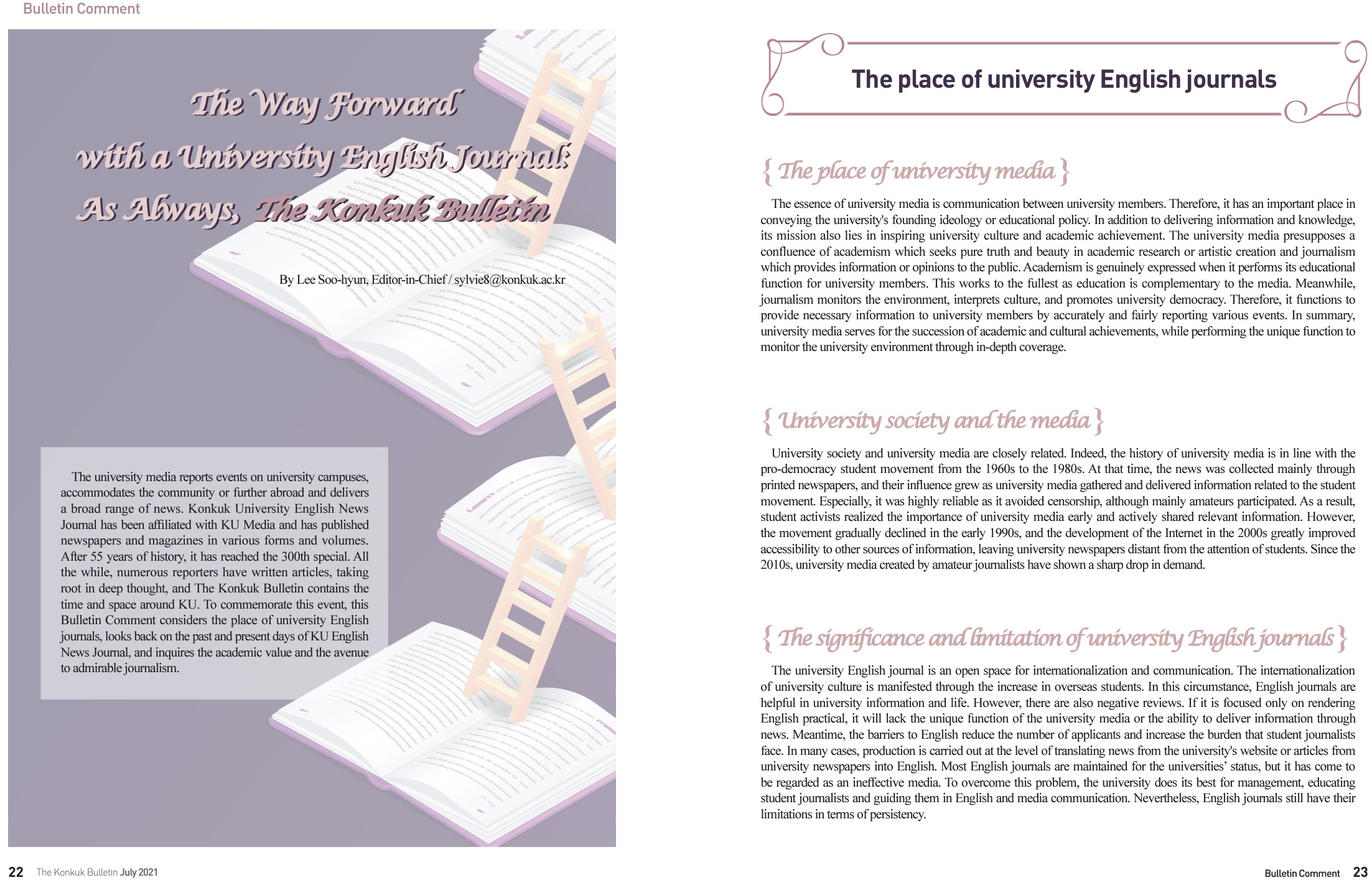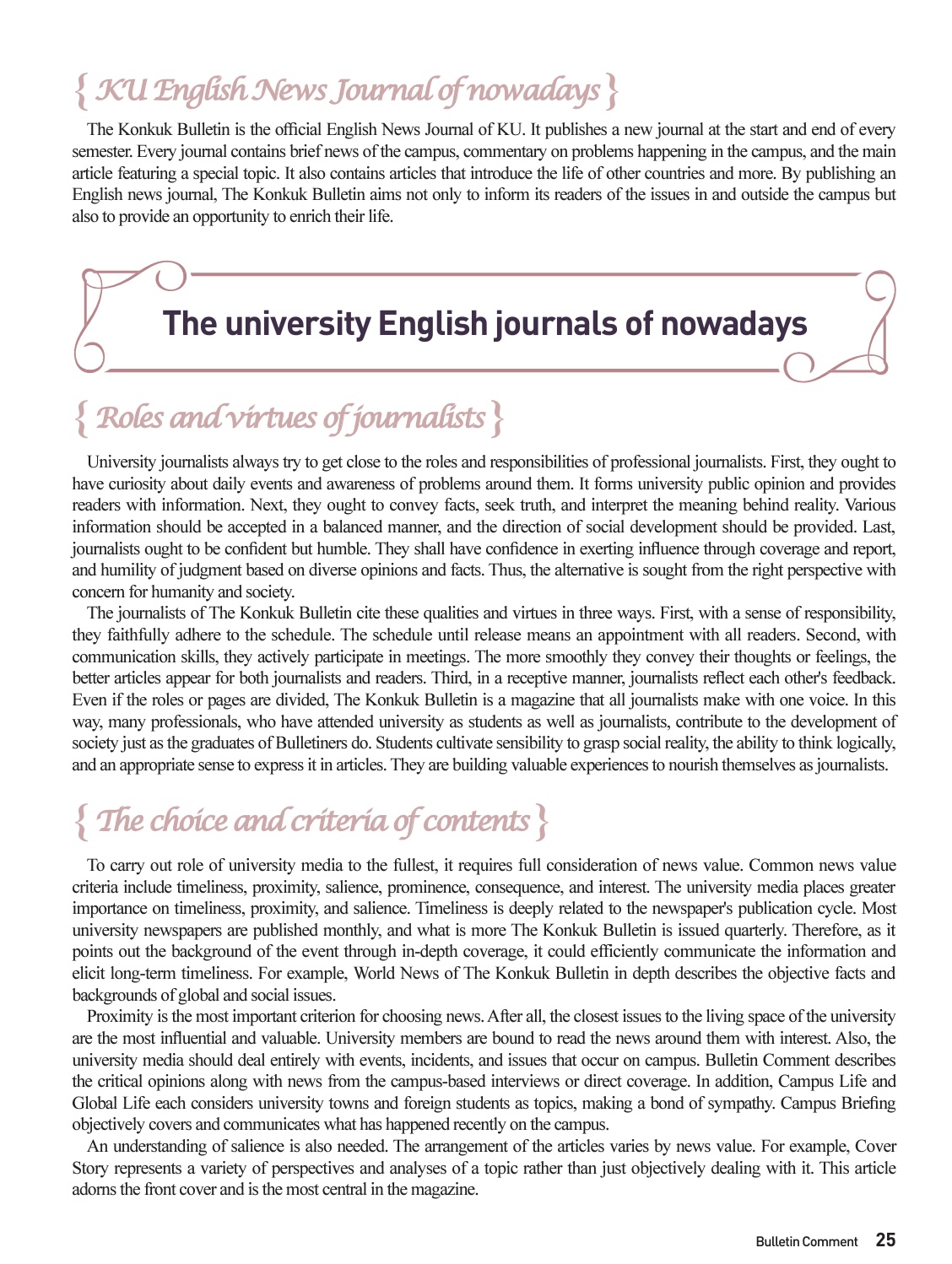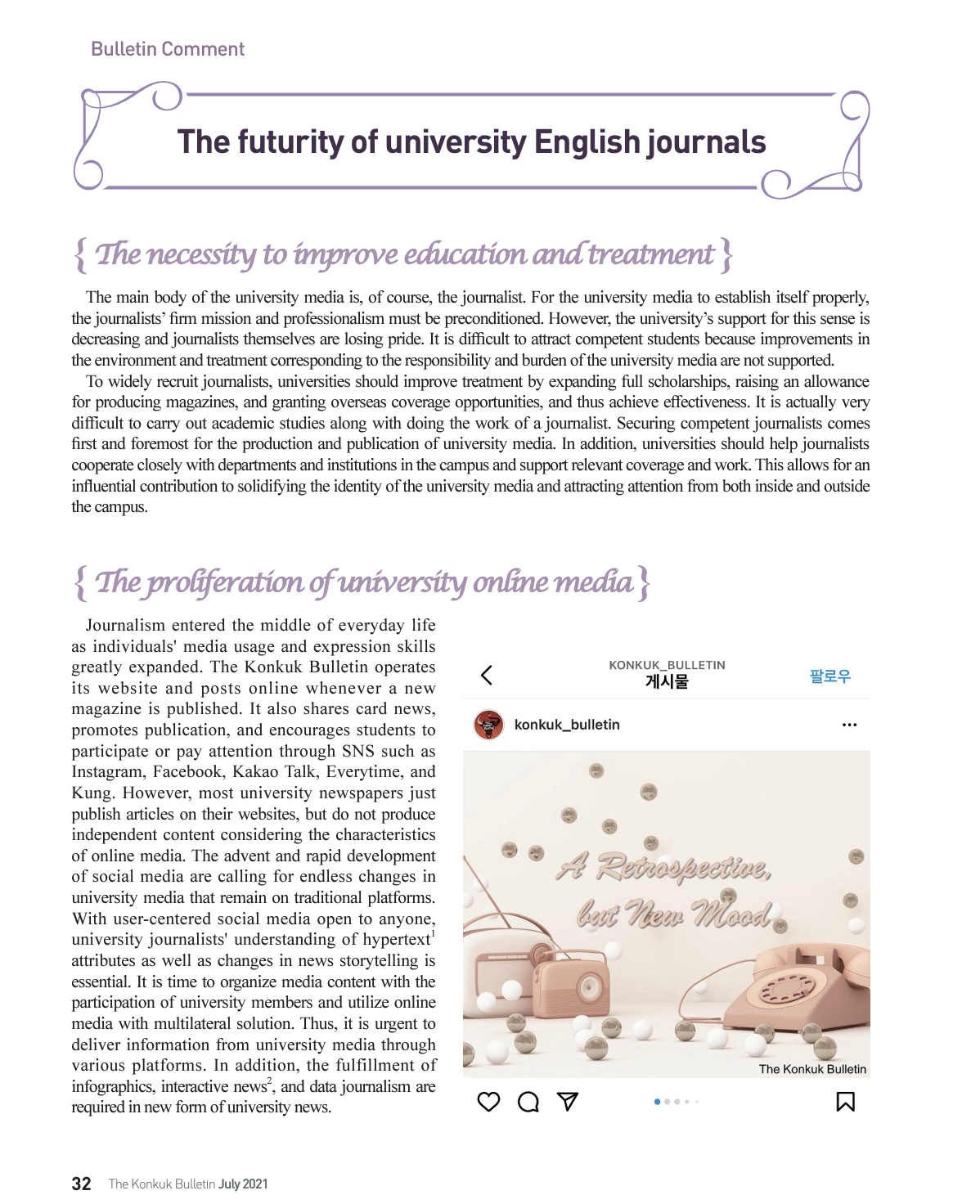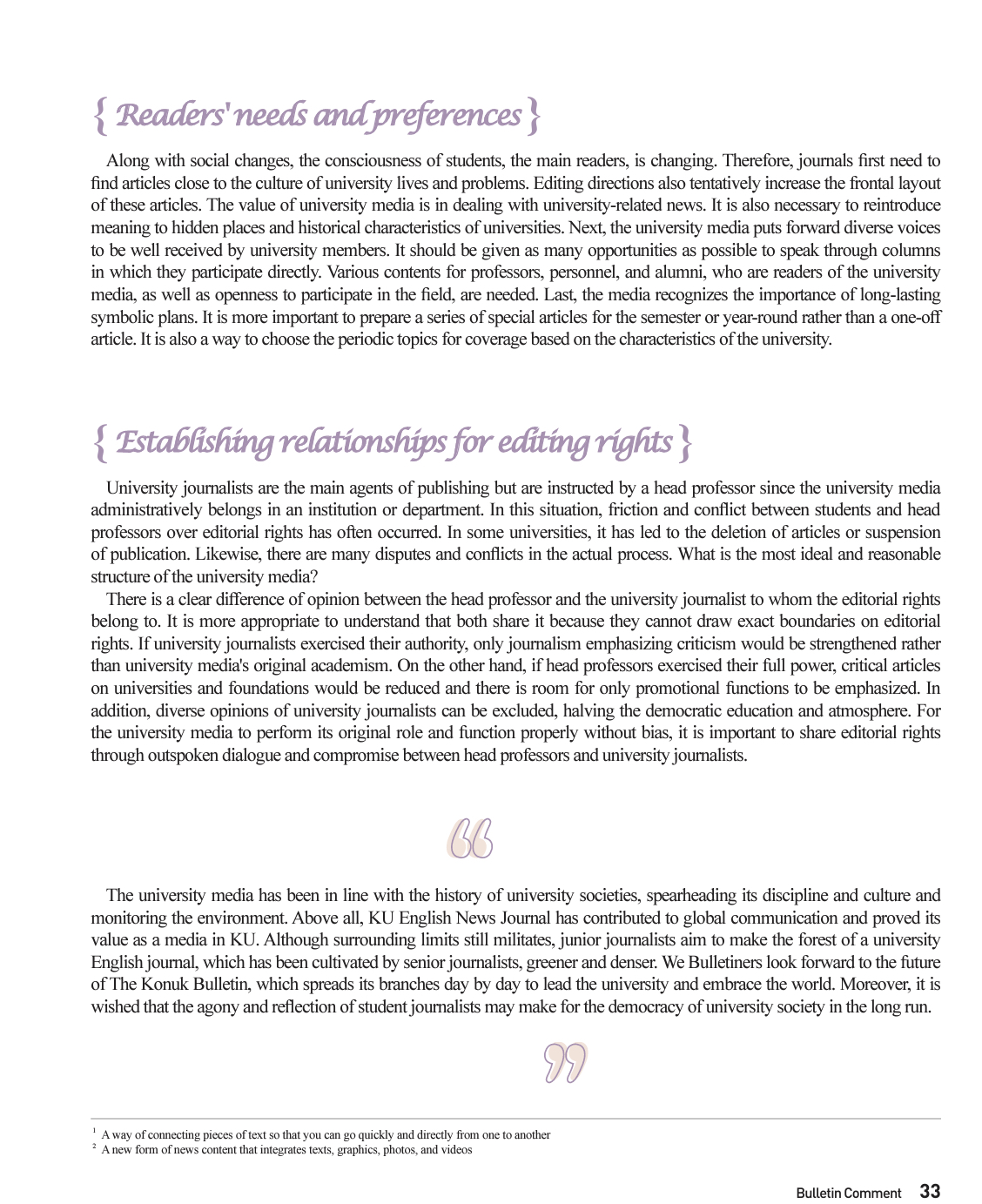|

|
The university media reports events on university campuses, accommodates the community or further abroad and delivers a broad range of news. Konkuk University English News Journal has been affiliated with KU Media and has published newspapers and magazines in various forms and volumes. After 55 years of history, it has reached the 300th special. All the while, numerous reporters have written articles, taking root in deep thought, and The Konkuk Bulletin contains the time and space around KU. To commemorate this event, this Bulletin Comment considers the place of university English journals, looks back on the past and present days of KU English News Journal, and inquires the academic value and the avenue to admirable journalism.
The place of university English journals
{ The place of university media }
The essence of university media is communication between university members. Therefore, it has an important place in conveying the university's founding ideology or educational policy. In addition to delivering information and knowledge, its mission also lies in inspiring university culture and academic achievement. The university media presupposes a confluence of academism which seeks pure truth and beauty in academic research or artistic creation and journalism which provides information or opinions to the public. Academism is genuinely expressed when it performs its educational function for university members. This works to the fullest as education is complementary to the media. Meanwhile, journalism monitors the environment, interprets culture, and promotes university democracy. Therefore, it functions to provide necessary information to university members by accurately and fairly reporting various events. In summary, university media serves for the succession of academic and cultural achievements, while performing the unique function to monitor the university environment through in-depth coverage.
{ University society and the media }
University society and university media are closely related. Indeed, the history of university media is in line with the pro-democracy student movement from the 1960s to the 1980s. At that time, the news was collected mainly through printed newspapers, and their influence grew as university media gathered and delivered information related to the student movement. Especially, it was highly reliable as it avoided censorship, although mainly amateurs participated. As a result, student activists realized the importance of university media early and actively shared relevant information. However, the movement gradually declined in the early 1990s, and the development of the Internet in the 2000s greatly improved accessibility to other sources of information, leaving university newspapers distant from the attention of students. Since the 2010s, university media created by amateur journalists have shown a sharp drop in demand.
{ The significance and limitation of university English journals }
The university English journal is an open space for internationalization and communication. The internationalization of university culture is manifested through the increase in overseas students. In this circumstance, English journals are helpful in university information and life. However, there are also negative reviews. If it is focused only on rendering English practical, it will lack the unique function of the university media or the ability to deliver information through news. Meantime, the barriers to English reduce the number of applicants and increase the burden that student journalists face. In many cases, production is carried out at the level of translating news from the university's website or articles from university newspapers into English. Most English journals are maintained for the universities’ status, but it has come to be regarded as an ineffective media. To overcome this problem, the university does its best for management, educating student journalists and guiding them in English and media communication. Nevertheless, English journals still have their limitations in terms of persistency.
KU English News Journal within KU Media
{ About KU Media }
KU Media currently consists of KU Press, Academy Broadcasting Station (ABS), and The Konkuk Bulletin. As the body in overall charge of communication, KU Press quickly and accurately covers, reports, and synthesizes public opinion of various news on and off campus. The reporters also lead university culture by publishing arguments or literary works by professors, students, and personnel. ABS plays its role as a flag bearer for university broadcasting, cultivating the sentiments of students and creating an atmosphere of study. ABS members produce broadcasts that approach students with a variety of content and convey the true meaning of the KU motto.
{ The old days of KU English News Journal }
KU English News Journal was founded to contribute to the cultivation of English proficiency and the creation of university culture based on the realization of proper academism and journalism. It covers and reports major news and publishes varied essays and columns every season through editorial meetings. It has accumulated solid experience and has been widely distributed to other universities across the country.
{ KU English News Journal of nowadays }
The Konkuk Bulletin is the official English News Journal of KU. It publishes a new journal at the start and end of every semester. Every journal contains brief news of the campus, commentary on problems happening in the campus, and the main article featuring a special topic. It also contains articles that introduce the life of other countries and more. By publishing an English news journal, The Konkuk Bulletin aims not only to inform its readers of the issues in and outside the campus but also to provide an opportunity to enrich their life.
The university English journals of nowadays
{ Roles and virtues of journalists }
University journalists always try to get close to the roles and responsibilities of professional journalists. First, they ought to have curiosity about daily events and awareness of problems around them. It forms university public opinion and provides readers with information. Next, they ought to convey facts, seek truth, and interpret the meaning behind reality. Various information should be accepted in a balanced manner, and the direction of social development should be provided. Last, journalists ought to be confident but humble. They shall have confidence in exerting influence through coverage and report, and humility of judgment based on diverse opinions and facts. Thus, the alternative is sought from the right perspective with concern for humanity and society.
The journalists of The Konkuk Bulletin cite these qualities and virtues in three ways. First, with a sense of responsibility, they faithfully adhere to the schedule. The schedule until release means an appointment with all readers. Second, with communication skills, they actively participate in meetings. The more smoothly they convey their thoughts or feelings, the better articles appear for both journalists and readers. Third, in a receptive manner, journalists reflect each other's feedback. Even if the roles or pages are divided, The Konkuk Bulletin is a magazine that all journalists make with one voice. In this way, many professionals, who have attended university as students as well as journalists, contribute to the development of society just as the graduates of Bulletiners do. Students cultivate sensibility to grasp social reality, the ability to think logically, and an appropriate sense to express it in articles. They are building valuable experiences to nourish themselves as journalists.
{ The choice and criteria of contents }
To carry out role of university media to the fullest, it requires full consideration of news value. Common news value criteria include timeliness, proximity, salience, prominence, consequence, and interest. The university media places greater importance on timeliness, proximity, and salience. Timeliness is deeply related to the newspaper's publication cycle. Most university newspapers are published monthly, and what is more The Konkuk Bulletin is issued quarterly. Therefore, as it points out the background of the event through in-depth coverage, it could efficiently communicate the information and elicit long-term timeliness. For example, World News of The Konkuk Bulletin in depth describes the objective facts and backgrounds of global and social issues. Proximity is the most important criterion for choosing news. After all, the closest issues to the living space of the university are the most influential and valuable. University members are bound to read the news around them with interest. Also, the university media should deal entirely with events, incidents, and issues that occur on campus. Bulletin Comment describes the critical opinions along with news from the campus-based interviews or direct coverage. In addition, Campus Life and Global Life each considers university towns and foreign students as topics, making a bond of sympathy. Campus Briefing objectively covers and communicates what has happened recently on the campus. An understanding of salience is also needed. The arrangement of the articles varies by news value. For example, Cover Story represents a variety of perspectives and analyses of a topic rather than just objectively dealing with it. This article adorns the front cover and is the most central in the magazine.
The futurity of university English journals
{ The necessity to improve education and treatment }
The main body of the university media is, of course, the journalist. For the university media to establish itself properly, the journalists’ firm mission and professionalism must be preconditioned. However, the university’s support for this sense is decreasing and journalists themselves are losing pride. It is difficult to attract competent students because improvements in the environment and treatment corresponding to the responsibility and burden of the university media are not supported. To widely recruit journalists, universities should improve treatment by expanding full scholarships, raising an allowance for producing magazines, and granting overseas coverage opportunities, and thus achieve effectiveness. It is actually very difficult to carry out academic studies along with doing the work of a journalist. Securing competent journalists comes f irst and foremost for the production and publication of university media. In addition, universities should help journalists cooperate closely with departments and institutions in the campus and support relevant coverage and work. This allows for an influential contribution to solidifying the identity of the university media and attracting attention from both inside and outside the campus.
{ The proliferation of university online media }
{ The proliferation of university online media }
Journalism entered the middle of everyday life as individuals' media usage and expression skills greatly expanded. The Konkuk Bulletin operates its website and posts online whenever a new magazine is published. It also shares card news, promotes publication, and encourages students to participate or pay attention through SNS such as Instagram, Facebook, Kakao Talk, Everytime, and Kung. However, most university newspapers just publish articles on their websites, but do not produce independent content considering the characteristics of online media. The advent and rapid development of social media are calling for endless changes in university media that remain on traditional platforms. With user-centered social media open to anyone, university journalists' understanding of hypertext1 attributes as well as changes in news storytelling is essential. It is time to organize media content with the participation of university members and utilize online media with multilateral solution. Thus, it is urgent to deliver information from university media through various platforms. In addition, the fulfillment of infographics, interactive news2, and data journalism are required in new form of university news.
{ The necessity to improve education and treatment }
The main body of the university media is, of course, the journalist. For the university media to establish itself properly, the journalists’ firm mission and professionalism must be preconditioned. However, the university’s support for this sense is decreasing and journalists themselves are losing pride. It is difficult to attract competent students because improvements in the environment and treatment corresponding to the responsibility and burden of the university media are not supported. To widely recruit journalists, universities should improve treatment by expanding full scholarships, raising an allowance for producing magazines, and granting overseas coverage opportunities, and thus achieve effectiveness. It is actually very difficult to carry out academic studies along with doing the work of a journalist. Securing competent journalists comes f irst and foremost for the production and publication of university media. In addition, universities should help journalists cooperate closely with departments and institutions in the campus and support relevant coverage and work. This allows for an influential contribution to solidifying the identity of the university media and attracting attention from both inside and outside the campus.
{ The proliferation of university online media }
Journalism entered the middle of everyday life as individuals' media usage and expression skills greatly expanded. The Konkuk Bulletin operates its website and posts online whenever a new magazine is published. It also shares card news, promotes publication, and encourages students to participate or pay attention through SNS such as Instagram, Facebook, Kakao Talk, Everytime, and Kung. However, most university newspapers just publish articles on their websites, but do not produce independent content considering the characteristics of online media. The advent and rapid development of social media are calling for endless changes in university media that remain on traditional platforms. With user-centered social media open to anyone, university journalists' understanding of hypertext1 attributes as well as changes in news storytelling is essential. It is time to organize media content with the participation of university members and utilize online media with multilateral solution. Thus, it is urgent to deliver information from university media through various platforms. In addition, the fulfillment of infographics, interactive news2, and data journalism are required in new form of university news.
{ Readers' needs and preferences }
Along with social changes, the consciousness of students, the main readers, is changing. Therefore, journals first need to f ind articles close to the culture of university lives and problems. Editing directions also tentatively increase the frontal layout of these articles. The value of university media is in dealing with university-related news. It is also necessary to reintroduce meaning to hidden places and historical characteristics of universities. Next, the university media puts forward diverse voices to be well received by university members. It should be given as many opportunities as possible to speak through columns in which they participate directly. Various contents for professors, personnel, and alumni, who are readers of the university media, as well as openness to participate in the field, are needed. Last, the media recognizes the importance of long-lasting symbolic plans. It is more important to prepare a series of special articles for the semester or year-round rather than a one-off article. It is also a way to choose the periodic topics for coverage based on the characteristics of the university.
{ Establishing relationships for editing rights }
{ Establishing relationships for editing rights }
University journalists are the main agents of publishing but are instructed by a head professor since the university media administratively belongs in an institution or department. In this situation, friction and conflict between students and head professors over editorial rights has often occurred. In some universities, it has led to the deletion of articles or suspension of publication. Likewise, there are many disputes and conflicts in the actual process. What is the most ideal and reasonable structure of the university media?
There is a clear difference of opinion between the head professor and the university journalist to whom the editorial rights belong to. It is more appropriate to understand that both share it because they cannot draw exact boundaries on editorial rights. If university journalists exercised their authority, only journalism emphasizing criticism would be strengthened rather than university media's original academism. On the other hand, if head professors exercised their full power, critical articles on universities and foundations would be reduced and there is room for only promotional functions to be emphasized. In addition, diverse opinions of university journalists can be excluded, halving the democratic education and atmosphere. For the university media to perform its original role and function properly without bias, it is important to share editorial rights through outspoken dialogue and compromise between head professors and university journalists.
There is a clear difference of opinion between the head professor and the university journalist to whom the editorial rights belong to. It is more appropriate to understand that both share it because they cannot draw exact boundaries on editorial rights. If university journalists exercised their authority, only journalism emphasizing criticism would be strengthened rather than university media's original academism. On the other hand, if head professors exercised their full power, critical articles on universities and foundations would be reduced and there is room for only promotional functions to be emphasized. In addition, diverse opinions of university journalists can be excluded, halving the democratic education and atmosphere. For the university media to perform its original role and function properly without bias, it is important to share editorial rights through outspoken dialogue and compromise between head professors and university journalists.
The university media has been in line with the history of university societies, spearheading its discipline and culture and monitoring the environment. Above all, KU English News Journal has contributed to global communication and proved its value as a media in KU. Although surrounding limits still militates, junior journalists aim to make the forest of a university English journal, which has been cultivated by senior journalists, greener and denser. We Bulletiners look forward to the future of The Konuk Bulletin, which spreads its branches day by day to lead the university and embrace the world. Moreover, it is wished that the agony and reflection of student journalists may make for the democracy of university society in the long run.
Lee Soo-hyun, Editor-in-Chief
sylvie8@konkuk.ac.kr





